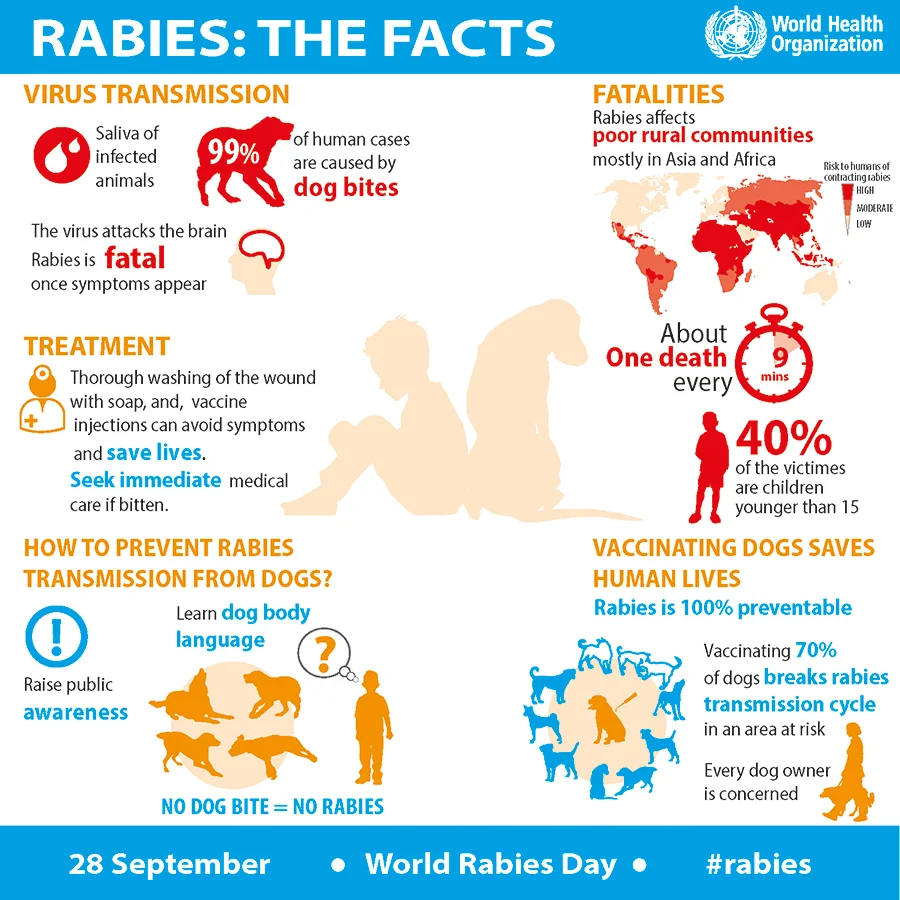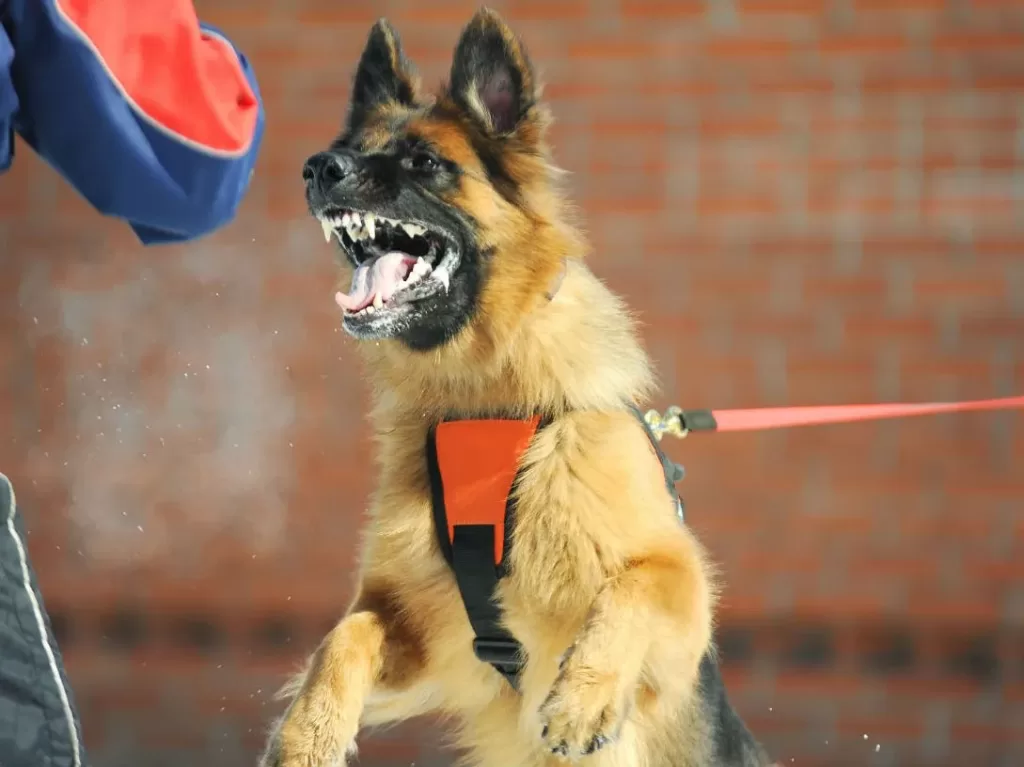Rabies in Dogs: As a dog owner, it is your responsibility to keep your dog healthy for the rest of his life.
Rabies is one of the most devastating diseases that can strike your four-legged friend.
Table of Contents

Once rabies comes to your dog, it is possible to send it to anyone who has bitten it. This is an emergency, you need to take immediate action.
What is rabies?
In both humans and dogs, rabies is primarily an infectious disease of the brain and spinal cord.
This condition is transmitted through physical contact with other dogs, so knowing that your dog is in contact with a cruel dog may prompt you to seek treatment or immunization for the condition.

The virus is usually transmitted by biting, so if you find that your dog has unexplained lesions on your body, you need a good reason to take it to the vet.
In such cases, the main goal is to make sure the dog is not infected.
Stages of Rabies in Dogs
| Stage | Description |
|---|---|
| 1. Exposure | Contact with rabid animal’s saliva or nervous tissue, often through a bite or scratch. |
| 2. Incubation | Virus multiplies silently, no visible signs, can last weeks to months. |
| 3. Prodromal | Early symptoms like restlessness, anxiety, fever, loss of appetite, and mild behavior changes. |
| 4. Furious Rabies | Extreme aggression, hypersensitivity, unpredictable behavior. |
| 5. Paralytic Rabies | Muscle weakness, paralysis, difficulty swallowing, excessive drooling, dropped jaw. |
| 6. Coma and Death | Coma-like state, almost always fatal, death occurs within days to weeks after symptoms appear. |
Understanding Rabies in Dogs: Signs and Stages
Rabies is a serious viral disease that can affect dogs and humans. It’s important to recognize its signs and stages to protect your furry friend and yourself. Let’s break it down in simple terms with illustrations and a chart.
Stage 1: Exposure
- Illustration: A dog encounters a rabid animal, often through a bite or scratch.
- Description: Rabies begins when a dog is exposed to the virus. This happens when they come into contact with the saliva or nervous tissue of a rabid animal, typically through a bite.
Stage 2: Incubation
- Illustration: A dog appears healthy and normal.
- Description: After exposure, there’s a period of incubation where the virus quietly multiplies. There are usually no noticeable signs during this stage, which can last from a few weeks to several months.
- The incubation period for the rabies virus in dogs can vary, but it typically ranges from several weeks to several months. During this incubation period, the virus is present in the dog’s body, but there are usually no visible signs or symptoms of rabies.
- The length of the incubation period can depend on various factors, including the location and severity of the bite or exposure, the amount of virus transmitted, and the individual dog’s immune response.
Stage 3: Prodromal
- Illustration: The dog becomes restless and anxious.
- Description: This stage marks the onset of early symptoms. Your dog may become restless, anxious, or agitated. They might also experience fever, loss of appetite, and mild changes in behavior.
Stage 4: Furious Rabies
- Illustration: The dog becomes highly aggressive and may attack.
- Description: Furious rabies is characterized by extreme agitation, aggression, and often, unpredictable behavior. Dogs may become hypersensitive to stimuli, causing them to snap or bite at anything that comes near.
Stage 5: Paralytic Rabies
- Illustration: The dog experiences muscle weakness and paralysis.
- Description: In this stage, the virus attacks the nervous system, leading to muscle weakness and paralysis. Dogs may have difficulty swallowing, drool excessively, and display a dropped jaw.
Stage 6: Coma and Death
- Illustration: The dog enters a coma-like state.
- Description: As the disease progresses, dogs can fall into a coma-like state. Unfortunately, rabies is almost always fatal once clinical signs appear. Death usually occurs within a few days to weeks after symptoms emerge.
What are the major warning signs you should look for?
The best way to reduce the risk of rabies becoming complicated and causing illness is to know what to look for.
Also Read: Best Online Dog Training Courses for 2021 during Covid Pandemic
By looking at some of the signs of the disease, you can detect when the dog is initially infected, which will give you enough time to seek medical help before the condition worsens.
Some of these signs are:
- Volatility: When you notice that your dog is more irritable than usual, you should always evaluate it by the vet. It is special if there is no obvious reason to behave the way it is doing.
- Increased Aggression: Most dogs have a basic level of aggression. If it gets worse in a short time, it indicates a rabies infection and you should seek the services of a veterinarian immediately.
- Fever and Irritation: You can tell that your dog has a fever by feeling its body but it is more accurate if you use a pet thermometer to check the readings.
- Low activity levels: This is a unique sign of illness, but it is always advisable to take the dog to the vet for testing to make sure it is not rabies.
- Biting: When you notice a high tendency for the dog to bite or hit people, it may be a sign that the infection is in its early stages.
Treatment for Rabies in dogs
Rabies in dogs is a serious and often fatal disease, and once symptoms become noticeable, there is no cure. This means that if your dog starts showing signs of rabies, such as extreme aggression or paralysis, there’s no treatment available to save them. A fact sheet from WHO says this
In such cases, veterinarians may recommend euthanasia to prevent the spread of the virus to other animals or even humans.
Prevention is the key when it comes to rabies. If your dog encounters a wild animal and gets bitten, it’s crucial to seek immediate veterinary attention. In some cases, a booster of the rabies vaccination may be administered. This booster helps boost your dog’s immune system against the rabies virus and reduces the likelihood of the virus taking hold.
However, if your dog has not been vaccinated against rabies and is bitten by a potentially rabid animal, the situation becomes much more dangerous. Rabies is transmitted through the saliva of infected animals, primarily through bites. Without the protection of a rabies vaccine, the virus can rapidly progress, and the outcome is usually fatal.
That’s why keeping your dog up to date with rabies vaccinations is so important. It not only protects your furry friend but also helps prevent the spread of this deadly disease to other animals and people. If you ever suspect your dog has been exposed to rabies or shows unusual behavior, don’t hesitate to contact your veterinarian immediately for guidance and treatment options.
how long can a dog live with rabies?
Also note that the initial symptoms usually appear 10 days after the dog is infected.
Once the virus enters the dog’s body, it is reflected in the muscle cells and then spreads to nerve fibers, including all peripheral, sensory, and motor nerves.
It then spreads to the central nervous system through fluid in the nerves.
The virus takes about a month to develop, but after the onset of symptoms, the virus grows rapidly and develops in one of two forms.
- Paralysis form
- angry form
The initial symptoms last for one to three days and then most dogs reach the angry stage.
The paralysis stage or a combination of both, while others become infected without exhibiting major symptoms.
Furious rabies is characterized by extreme behavioral changes, including overt aggression and “aggressive” behavior.

Paralysis rabies involves weakness, loss of coordination and paralysis. If the virus is not treated immediately after the onset of symptoms, the prognosis is very low.
How to know if the dog has rabies after biting

Knowing whether a dog has rabies is a critical concern for the safety of both animals and humans. Here are various scenarios and real-life examples that highlight how you can determine if a dog might have rabies:
1. Unusual Behavior:
- Scenario: A normally friendly and docile dog suddenly becomes aggressive, disoriented, or overly agitated.
- Real-Life Example: A family’s beloved pet dog, who was known for his calm demeanor, starts growling and biting without provocation. This abrupt change in behavior raises suspicions of rabies.
2. Biting Incidents:
- Scenario: A dog bites a person or another animal, and there’s uncertainty about the dog’s vaccination status.
- Real-Life Example: A stray dog bites a child while playing in the park. Since no one knows the dog’s vaccination history, there’s concern about the potential transmission of rabies, leading to a need for immediate investigation.
3. Contact with Wildlife:
- Scenario: A dog has had contact with wild animals known to carry rabies, such as raccoons, skunks, or bats.
- Real-Life Example: A family’s dog regularly roams the backyard and frequently encounters raccoons. One day, the dog starts exhibiting strange behavior, prompting concerns about possible rabies exposure.
4. Symptoms Progression:
- Scenario: A dog displays initial symptoms like excessive drooling, difficulty swallowing, or paralysis.
- Real-Life Example: A dog initially shows signs of rabies, such as foaming at the mouth and difficulty swallowing. As the symptoms worsen and progress through the stages, it becomes increasingly likely that rabies is the cause.
5. Known Exposure:
- Scenario: A dog is known to have been bitten by a potentially rabid animal.
- Real-Life Example: A family’s dog is attacked by a bat in the backyard, and there’s visible evidence of a bite wound. This clear exposure to a potential rabies carrier necessitates immediate assessment.
6. Geographic Location:
- Scenario: A dog resides in an area with a higher prevalence of rabies cases.
- Real-Life Example: Dogs in regions with known rabies outbreaks or a high incidence of rabies cases are at greater risk. Even without visible symptoms, the location can raise concerns about potential exposure.
7. Vaccination History:
- Scenario: Lack of up-to-date rabies vaccinations in a dog.
- Real-Life Example: A dog that has not received regular rabies vaccinations may be at higher risk if exposed to rabies carriers. Authorities may require quarantine or testing in such cases.
In all these scenarios, it’s essential to contact a veterinarian or local animal control immediately if there are any suspicions of rabies. Timely intervention, including observation, quarantine, or testing, can help determine if the dog has rabies and take appropriate actions to protect public health. Rabies is a deadly disease, and early detection and prevention are paramount.
Prevention of Rabies: What should you do?
Preventing rabies in dogs is crucial for protecting both our four-legged friends and people. The most effective way to do this is through vaccination. When dogs, even puppies, receive the rabies vaccine, it acts as a shield against the disease, stopping it in its tracks. This is not only important for dogs but also for humans because it prevents the virus from being transmitted to people.
Additionally, vaccinating dogs reduces the need for Post-Exposure Prophylaxis (PEP), which is the series of shots humans have to get if they’re bitten by a potentially rabid animal. By preventing rabies in dogs, we’re also preventing the potential risk to humans.
But it’s not just about vaccinations. Educating both children and adults about dog behavior and how to prevent bites is equally important. Understanding how to interact safely with dogs can significantly reduce the chances of getting bitten. This education is like an extra layer of protection against rabies because fewer dog bites mean a lower risk of human rabies cases.
By combining vaccination programs for dogs with education on dog behavior and bite prevention, we can not only decrease the number of human rabies cases but also reduce the financial burden associated with treating dog bites. This two-pronged approach is a powerful tool in our fight against rabies, keeping our furry companions and our communities safer.

